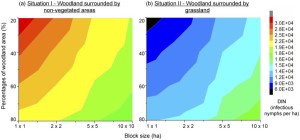By Hannah Staab
Even though climate change is believed to be a major influence on tick abundance and Lyme infections around the world, there are other human practices that have the potential to contribute to the spread of ticks and Lyme disease. A study by Simon et al. (2014) discussed the reasons that ticks and white-footed mice might be spreading from the northeastern US into southern Canada. In addition to increasing global temperatures, land fragmentation could be a huge factor in changing tick abundance.
Woodlands are being destroyed to build cities and agricultural fields, breaking forests into smaller and smaller units of land. Deforestation and land fragmentation are suspected to be why Lyme might be spreading so rapidly, but this idea is highly contested and there have been studies pointing in both directions even as research continues.
Studies conducted across various European regions investigated this hypothesis and found a significant effect of certain elements of land fragmentation on infected tick abundance. Research done in central France and Belgium has revealed that land with more forest edge has a higher prevalence of infected ticks. Other studies identified the transition areas between woodlands and developed areas as another factor in tick abundance in the Latvian countryside as well as in northern Spain. Li et al. (2012) conducted an experiment that followed up on these studies and supported their findings, discovering the importance of adjacent land cover, or “transition area”, in particular.
Li et al. used computer models to test a diverse range of land use scenarios. The land parcels varied in size and adjacent land cover, or “transition area” between woodlands. Using the models, they predicted the tick nymphal infection prevalence (NIP) and density of infectious nymphs (DIN) at the various sites. Results suggested that decreasing the size of the blocks of land led to an increase of NIP and DIN in woodlands adjacent to non-vegetated areas. However, when the adjacent land cover was grass instead of a non-vegetated area, the NIP and DIN measures decreased, showing that adjacent land cover can make a significant impact on the Lyme risk in an area.
The presence of the grasslands beside woodlands led to a lower risk of Lyme in the woodlands because of lowered tick survival rate. This is because the ticks would spread out into nearby grasslands, where many would not survive, since available hosts like mice and deer are scarcer, rather than concentrated into small areas. This larger land area dilutes the amount of infected ticks in the woodlands, and lowers the risk of being infected with Lyme. According to this study, land fragmentation does have an effect on the prevalence of infected ticks, and having grasslands adjacent to woodlands instead of non-vegetated areas is an effective way to reduce the risk of Lyme in a habitat.
A study by Zolnik et al. (2015) voiced an opposing perspective, arguing that land fragmentation does not contribute to the prevalence of infected ticks in wooded areas. The authors instead proposed that, it is high biodiversity in a community that reduces the risk of Lyme and tick-borne illnesses, by diminishing the abundance of reservoir species like the white-footed mouse. However, they found that levels of biodiversity had no significant effect on the amount of infected ticks. Thus, the effect of land fragmentation on variables other than host biodiversity may impact the abundance of infected ticks.
Even though this topic is still highly debated, many studies expose the likelihood that human interventions in woodlands and nearby areas have the potential to put people at a higher risk for Lyme disease. Common human practices such as deforestation, clearing land for agriculture or to create urban areas, mowing down grasslands, and fencing in forests, all have consequences when it comes to infected tick prevalence. As we continue deforestation, we are creating smaller patches of land where, many studies have shown, that the density of infected nymphs increases. More research is necessary to know the full effects of land fragmentation on Lyme disease risk. But while we are making future plans or thinking about how to manage our land, the potential impact on tick populations should definitely be taken into consideration.
Figure 1. How tick abundance varies based on land block size and percentage of woodland area in those units of land. This is shown in two situations. Situation I being when the blocks of land are adjacent to non-vegetated area, and Situation II where the blocks of land are adjacent to grassland. The color scale on the right shows the number of infectious ticks per hectare of land, red signifying more ticks in an area, and blue signifying less. This shows that the smallest patches with least woodland cover have the most infected ticks when it is surrounded by non-vegetated area and have the least amount of infected ticks when it is surrounded by grassland. Adapted from Li et al. (2012) PLoS ONE Vol. 7(6) page 1-12.
For more on Lyme disease and climate change, click here.

GLA
Admin at GLA
